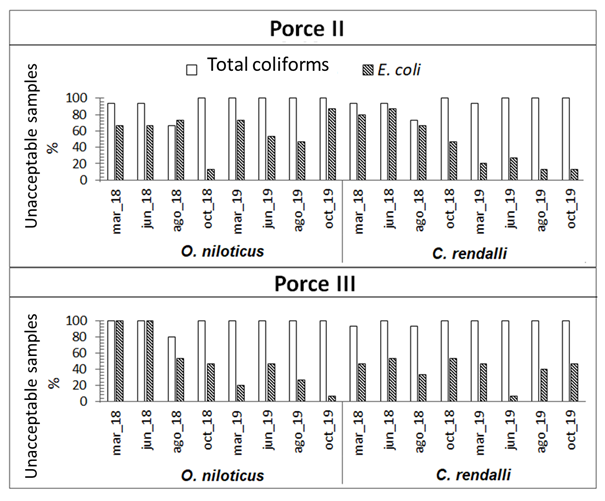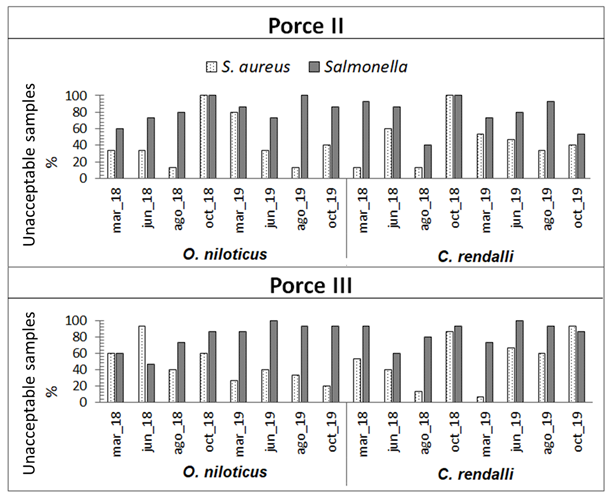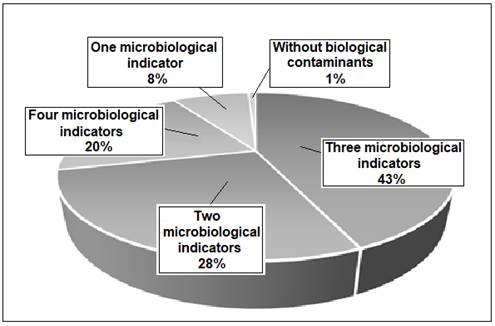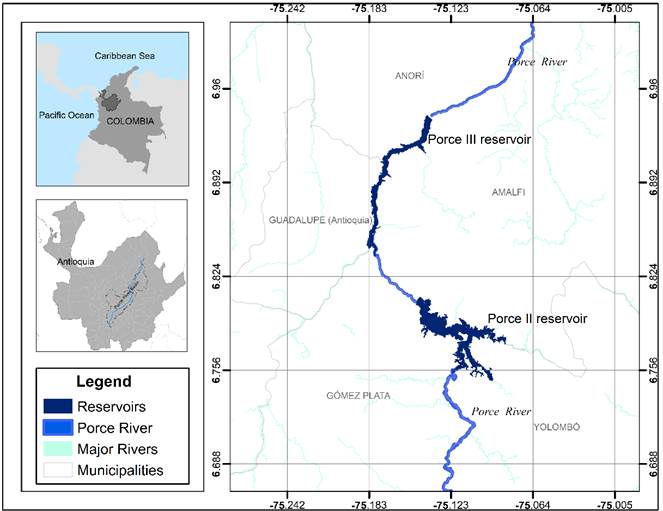INTRODUCTION
From capture to final consumption, fish goes through a series of stages where it is susceptible to microbiological contamination (Brugman et al., 2018; Legrand et al., 2019). In contaminated waters and degraded habitats, the degree of contamination of fish can be high, where the microbial species and quantity make human consumption of the fish risky (Dumen et al., 2020; Gastalho et al., 2014; Rodriguez et al., 2018). In this sense, different genera of microorganisms associated with contamination (Arizmendi, 2018) and deterioration of fish have been reported, such as the presence of fecal coliforms, Escherichia coli and Salmonella spp., which in fish muscle indicate direct fecal contamination due to poor techniques in the fishing operation and/or its handling (Brugman et al., 2018; GAIA, 2011; Rodríguez et al., 2018). Colombian Technical Standard NTC 1443 of 2016 establishes E. coli, Salmonella spp., Vibrio cholerae and coagulase-positive Staphylococcus aureus as microbiological contamination indicators for whole fish, medallions, fillets, and pieces (refrigerated or frozen). These microorganisms are important in terms of public health because they can cause consumer illnesses known as foodborne diseases (FBDs). If consumed, the presence of these pathogens in fish can cause fever, stomach pains and severe digestive problems such as common gastroenteritis due to salmonellosis or typhoid fever (WHO, 2021; Rodriguez et al., 2018; Sheng and Wang, 2020). Additionally, these pathogens can generate significant physical damage to fish and promote endotoxin accumulation (Brugman et al., 2018; Colombo et al., 2018; Lalitha and Prasad, 2019).
It is common to find exotic fish species in reservoirs that provide an ecosystem service for nearby populations. Such is the case of the Porce II and Porce III reservoirs, where the presence of exotic fish species allows the development of artisanal fishery, for self-consumption and commercialization, which is important and fundamental for the subsistence of rural populations that depend on it (Jiménez Lopera, 2020). According to López Sánchez et al. (2018), there are 67 active fishermen in Porce II, 70% of which obtain their main source of income from artisanal fishing and 85% of the catch is destined for commercialization with the remainder for self-consumption. The fishery in the area is mainly supported by the exotic cichlids Oreochromis niloticus and Coptodon rendalli, which accounted for 96% of the total catch in the Porce II reservoir in 2018. This reservoir has a fisheries management plan (POP) approved by the National Aquaculture and Fisheries Authority (AUNAP, 2013) through resolution 970 of 2015, for the integrated management of the fishery and aquaculture resource. The POP emphasizes the sustainability of the fishery resources and the prevention of overfishing. However, the catching and handling of the fish and conservation, are carried out with low hygiene standards and inadequate infrastructure (Barrera and Contreras, 2021; Dovale, 2019; Suárez Ceballos and Flórez Sepúlveda, 2021).
Additionally, the reservoirs present low water quality since its main tributary, the Porce River, carries chemical and organic pollutants from ten municipalities of the Aburrá Valley. This includes the city of Medellín which, as a consequence of the constant inflow and damming, augment the growth of microorganisms including pathogens (Arizmendi, 2018; Winton et al., 2022; Zapata Restrepo et al., 2017). The high loads of contaminants in these reservoirs can influence the sanitary quality and safety of the fish product and generate a public health problem due to its consumption and commercialization (Suárez Ceballos and Flórez Sepúlveda, 2021). At present, there is no information on microbiological indicators that allow for the establishment of fish quality and the possible risks for consumers. Consequently, this study seeks to determine the bacterial microbiological quality in muscle tissue of O. niloticus and C. rendalli from Porce II and Porce III reservoirs using indicators of total coliforms, thermotolerant E. coli, coagulase positive S. aureus and Salmonella spp.
MATERIALS AND METHODS
Study area
The study was carried out in the Porce II and Porce III reservoirs located in the northeast of the department of Antioquia, Colombia. The Porce II reservoir is located 120 km from the city of Medellín, between coordinates 75º09'14"- 75º04'59" W and 6º44'57" - 6º48'45" N, in the jurisdiction of the municipalities of Gómez Plata, Amalfi, Yolombó and Guadalupe (Figure 1). The useful capacity of the Porce II reservoir is 96.2 million m3. The Porce III reservoir is located approximately 147 km from Medellín, in the jurisdiction of the municipalities of Amalfi, Anorí, Gómez Plata and Guadalupe (Figure 1). Air temperature fluctuates between 13 °C and 26 °C and relative humidity between 80% and 84%.
Sampling
Eight collections were conducted between March 2018 and October 2019 from local fishermen who use traditional fishing methods (hook and trawl netting). In each collection, 15 eviscerated adults, freshly taken from each reservoir and from each of the following species, O. niloticus and C. rendalli, were purchased from nearby reservoirs and stockpiles. A total of 480 specimens weighing more than 100 g and without discriminating between sexes were analyzed. The fish were transported in coolers with ice to preserve the cold chain and the muscle was extracted by qualified laboratory personnel in an adequate space and under aseptic conditions within a period of no more than three hours after purchase. The weight, standard length and total length were determined for each specimen. To obtain the muscle of each fish, the fillet was extracted through a longitudinal cut of both lateral halves from the base of the tail to the base of the head and the skin was removed. From the extracted muscle, ten grams were separated for microbiological analysis for the detection of total coliforms, thermotolerant E. coli, coagulase-positive S. aureus and 25 g for the identification of Salmonella spp. The remaining tissue was used for physicochemical analysis not considered in this study. The muscle cuts were stored in sterile bags duly labeled and kept at -4 ºC for transport to the laboratory and subsequent analysis within a period of no more than five days.
Research permissions and ethical considerations
The project was endorsed by the ethics committee for animal experimentation of the University of Antioquia as coast in Act Nº114 of December 7, 2017, and covered by the macro research permit granted to the university by resolution 0524 of May 27, 2014. We chose to buy fish from fishermen to avoid overfishing as well as the fact that this activity does not require a special permit. Fish were received at the collection site after each fishing operation and were processed by trained personnel from the research team.
Microbiological analysis
Culture media
For the detection of microbiological indicators, commercial culture media were used according to manufacturer's instructions. Sterility tests and controls were performed for each culture medium and were kept refrigerated for no more than one week. The culture media, reagents, diluents, and equipment used have validation and verification certificates. The analyses were performed in the laboratory of the Environmental Management and Modeling Research Group (GAIA) of the University of Antioquia, accredited by IDEAM, following the general requirements and guidelines for a microbiological analysis laboratory (NTC 4092). To favor cell growth and minimize the risk of reporting false negatives in the final results, bacteria pre-enrichment of total coliforms, thermotolerant E. coli and coagulase positive S. aureus was performed by transferring ten grams of whole muscle from each specimen to sterile nutrient broth for three hours at 36 ºC. Microbiological indicators were used for cell identification.
Identification of total coliforms and thermotolerant Escherichia coli
According to NTC 4458: 2018, the methodology of membrane filtration with culture on chromogenic agar was used for the analysis of microbiological indicators in food and water. Previously, a 101 dilution of the sample was prepared in sterile water. The diluted sample was filtered using sterile filters of 0.45 microns and the filter was brought to the surface of Chromocult agar. Total coliforms were incubated at 35 ± 1 °C for 24 hours and thermotolerant E. coli at 44 ± 1 °C for 18 to 20 hours. On Chromocult agar, E. coli colonies showed a blue hue, total coliforms were purple and other associated enterobacteria were colorless. The analyses were done in duplicate, and the results were reported as Colony Forming Units per gram of sample (CFU/g).
Identification of coagulase-positive Staphylococcus aureus
For the identification of coagulase-positive S. aureus, the NTC 4779:2007 standard was followed using BD Baird Parker agar, a moderately selective and differentiating culture medium for the isolation and enumeration of this indicator in food, environmental and clinical samples. 100(l of the sample was inoculated onto the culture medium by surface seeding and incubated at 35 ± 2 °C for 24 to 48 hours. To confirm the presence of coagulase-positive bacteria, typical (black-gray, with metallic sheen and halo) and atypical colonies were selected and transferred to tubes with brain-heart infusion broth and incubated at 35 ± 2 °C for 24 hours. 0.1 mL of each culture was added to 0.3 mL of rabbit plasma, incubated for four to six hours at 35 ± 2 °C, and the plasma clot was examined. The test was considered positive if the volume of the clot occupied from one-fourth of the original volume of the liquid. Cases with negative results were incubated for an additional 24 hours for confirmation.
Identification of Salmonella spp.
Twenty-five g of muscle tissue were transferred to lactose broth for sample pre-enrichment and incubated at 37 ± 1 °C for 18 ± 2 hours. Subsequently, enrichment was performed in tetrationate selective broth for 24 ± 3 hours at 37 °C and finally the samples were seeded using streak seeding on XLD and Bismuth sulfite selective agars, with incubation at 35 ± 2 °C for 48 hours (NTC 4574:2007). Typical colonies of Salmonella spp. on XLD agar were evidenced as shiny black colonies and the culture medium turning a yellow-pink color, and the appearance of brown, gray or black colonies with metallic sheen on Bismuth sulfite agar. The results were reported as presence/absence of Salmonella spp.
Data analysis
Statistical analyses were performed using Statgraphics centurion version 19.1.2 and Excel. The data did not follow a normal distribution. The Mann Whitney U test was used to evaluate differences between two medians and the Kruskal Wallis test was used for multiple comparisons. Significant differences were considered with a value of p<0.05. The Chi-square hypothesis test was also performed to determine differences between the frequency of unacceptable samples between Porce II and Porce III reservoirs with a significance value of 0.05.
RESULTS
The number and percentage of O. niloticus and C. rendalli samples (Table 1) unfit for consumption were obtained according to NTC 1443/2016 regulations, where total coliforms are excluded as a critical indicator. However, this indicator was analyzed in this study. Of the 480 fish analyzed, 23 in Porce II (O. niloticus = 12 and C. rendalli = 11) and 9 in Porce III (O. niloticus= 3 and C. rendalli = 6) presented good or acceptable quality for human consumption. Total coliforms and Salmonella spp. were found in greater proportion in the samples collected in this study. Of 480 samples, 461 (96%) exceeded the maximum level (>400 CFU/g) for total coliforms, and the presence of Salmonella spp. was detected in 390 (81.3%). In general, the number of fish samples unfit for consumption according to Colombian regulations for the indicators considered in this study was significantly higher than the number of acceptable samples (W = 1024, p <0.05), suggesting poor bacterial microbiological quality of the fishery resource in the study area.
Table 1 Specimens of O. niloticus and C. rendalli with unacceptable quality by indicator in Porce II and Porce III reservoirs
| Indicator (NTC 1443/2009-2016) | Oreochromis niloticus | Coptodon rendalli | ||
|---|---|---|---|---|
| Porce II | Porce III | Porce II | Porce III | |
| Coliforms totals a | 113 (94.2%) | 117 (97.5%) | 113 (94.2%) | 118 (98.3%) |
| Escherichia coli thermotolerant a | 72 (60%) | 60 (50%) | 53 (44.2%) | 49 (40.8%) |
| Staphylococcus aureus b | 52 (43.3%) | 56 (46.6%) | 54 (45%) | 63 (52.5%) |
| Salmonella spp. c | 99 (82.5%) | 96 (80%) | 93 (77.5%) | 102 (85%) |
a Samples (number and percentage) with unacceptable quality (>400 CFU/g)
b Samples (number and percentage) with unacceptable quality (>1000 CFU/g)
c Samples (number and percentage) with unacceptable quality (presence)
n = 120
The samples presented a high proportion of contamination by total coliforms in all sampling. In four of the samples from Porce II and five from Porce III, 100% presented contamination by this indicator (Figure 2). For thermotolerant E. coli, a greater balance was shown in the proportion of acceptable and non-acceptable samples in both reservoirs for both species, only in O. nilotucus in Porce III (March 2018 and June 2018) were 100% of the samples contaminated with non-acceptable levels of this indicator (Figure 2).

Figure 2 Percentage of unacceptable samples per sampling for the indicators total coliforms and thermotolerant E. coli.
Figure 3 shows that 100% of the specimens captured (O. niloticus and C. rendalli) were contaminated with Salmonella spp. for a total of 388 specimens (190 in Porce II and 198 in Porce III) in October 2018 in Porce II reservoir and June 2019 in Porce III reservoir. In total, 107 specimens were found contaminated with S. aureus - coagulase positive in Porce II and 119 in Porce III. In October 2018 in both reservoirs and in October 2019 in Porce III, more than 80% of the samples were positive for S. aureus - coagulase positive (Figure 3).

Figure 3 Percentage of unacceptable samples per sampling for S. aureus coagulase positive and Salmonella spp. indicators.
Considering the total number of samples analyzed, a high percentage of unacceptable samples were found for three of the indicators analyzed, with only 1% of the samples showing the absence of the bacteria evaluated (Figure 4).

Figure 4 Percentage of non-compliance of samples in relation to the number of microbiological indicators evaluated.
As for the analysis of each bacterial contamination indicator in fish, the same trend was found for both fish species in both reservoirs. The indicators total coliforms and Salmonella spp. showed statistically significant differences (p < 0.001) between acceptable and unacceptable samples for human consumption with a high number of samples contaminated with these bacteria and not complying with the regulations for consumption (NTC 1443/2009-2016). On the other hand, for thermotolerant E. coli and coagulase-positive S. aureus, no statistically significant differences were found (p > 0.06) between acceptable and non-acceptable samples, suggesting a better balance in the quality of the fish, although contamination by these two microbiological indicators should not be ignored. In general, according to these results, fish from both reservoirs are poor in quality and unfit for human consumption although there is a significantly greater tendency to obtain fish unacceptable for consumption in the Porce III reservoir (X2 = 6.5; e = 1; p < 0.05).
DISCUSSION
Bacterial contamination of fish comes from two main sources, habitat contamination and the presence of endogenous microorganisms in the fish. However, the presence of microorganisms in muscle, a tissue that in fresh fish is usually sterile, is mainly caused by inadequate handling during capture and processing, which favors microorganisms located in the skin, gills and gastrointestinal tract that can penetrate and multiply, thereby promoting subsequent tissue deterioration (Dumen et al., 2020; Rodriguez et al., 2018; Sheng and Wang, 2020). The microbiological safety of fish growing in the Porce II and Porce III reservoirs is deplorable due to the deterioration of water quality caused by the constant inflow of sewage from 4,055,296 people living in the Aburrá Valley (Arizmendi, 2018; DANE, 2020). The microbiological contamination is exacerbated by bad practices, as these fish are eviscerated and washed with contaminated water from both reservoirs, an in situ process that is performed in an unsanitary manner on wooden boats that also act as reservoirs of microorganisms and favor cross-contamination (personal observation). Finally, fish from the examined reservoirs are transported to nearby stockpiles in buckets, bags or cloth sacks and are rarely frozen at adequate temperatures (Suárez Ceballos and Flórez Sepúlveda, 2021).
According to the fourth update of NTC 1443 of 2016, the level of microbiological indicators that generate danger to human health and that are a requirement for the commercialization of whole fish, medallions, fillets and fresh pieces (refrigerated or frozen) are: Escherichia coli (>400 CFU/g), Salmonella spp. (presence), Vibrio cholerae (presence) and coagulase positive Staphylococcus aureus (>1000 CFU/g). In this study, the presence of total coliforms (>400 CFU/g) contemplated in the previous update (NTC 1443 of 2009) was also quantified. The presence of one or more of these microorganisms in more than 90% of the samples evaluated in this study suggests direct contamination of the product with contaminated water or secondary contamination during capture, handling, processing, storage or distribution of the product. It is important to highlight that these pathogenic bacterial species were identified in up to 100% of the fish analyzed per campaign.
The results obtained indicate that fish from both reservoirs pose a public health risk to consumers. The presence of total coliforms and thermotolerant E. coli in fish muscle is associated with fecal contamination, indicating that the food product was contaminated by feces (Lerma Fierro et al., 2020; Molina and Jiménez, 2017). The microbiological indicator Salmonella was found in 81% of the specimens analyzed, which according to Fernandez et al. (2018) is due to poor handling in the marketing chain and inadequate sanitation, resulting in the formation of biofilms (Palomino Camargo et al., 2018; Sheng and Wang, 2020). The mere presence of this indicator in fish means a potential health risk for consumers as this bacterium is responsible for severe gastroenteritis and typhoid fever (Dumen et al., 2020; INS, 2017). Likewise, the indicator S. aureus coagulase positive was found in approximately 40% of fish and is considered one of the first causes of food poisoning due to the generation of heat-resistant enterotoxins with high virulence in mammals (Lalitha and Prasad, 2019; Roldán Acero, 2020).
Poor safety conditions were present in both species and both reservoirs. However, a higher frequency of samples unfit for human consumption was observed in Porce III reservoir, possibly because fishing activity in this reservoir is much less regulated than in Porce II, which has a fisheries management plan (POP) approved by the National Aquaculture and Fisheries Authority (AUNAP) through resolution 970 of 2015 for the integrated management of fishery resources. Further, there are fishermen's associations formed in Porce II that control the capture and marketing of fish (Jiménez Lopera, 2020). It would be expected that due to the dilution of contaminants and damming in the Porce II reservoir, further downstream the concentration of contaminants would decrease and water quality would improve in the Porce III reservoir. However, the results obtained support the hypothesis that the greater contamination of fish is mainly due to the handling of fish.
As shown in Figure 4, only 8% of the fish analyzed were unfit for consumption when only one microbiological indicator was taken into account. This study demonstrates the importance of using a battery of microbiological indicators to evaluate and monitor the quality of fish products for human consumption, especially those from contaminated reservoirs such as these dams.
Although the origin and high exposure to environmental contaminants of these fish is not suitable for their commercialization and can generate a public health problem, adequate training of fishermen in the use of food safety and handling techniques could improve the microbiological quality of fish from these reservoirs (Barrera and Contreras, 2021; Roldán Acero et al., 2020). It should be noted that most fishermen in this area do not have knowledge of basic hygiene and food safety standards (Meneses and Nieto, 2015; Rondón et al., 2020). Therefore, considering the use of adequate boats, ex situ processing in places where asepsis is guaranteed, the use of potable water and adequate cold storage could reduce the growth of pathogenic bacteria. Transportation of live fish to appropriate processing sites could also increase the quality of the product. Likewise, changes in economic activity generated by the intervention of populations for the construction of macro-projects such as reservoirs or dams can negatively alter the socioeconomic development of these communities. These modifications are not recommended due to the great social and environmental impact they cause in the short and long term (Jiménez Lopera, 2020).















